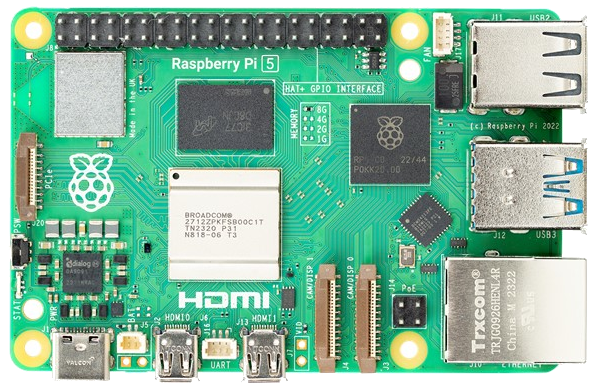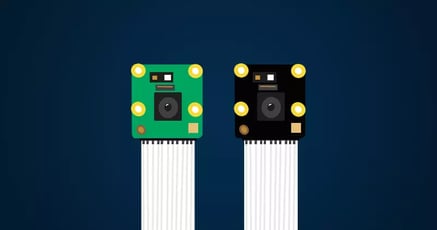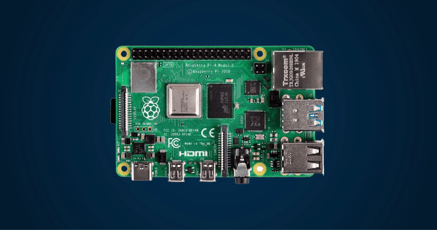The Raspberry Pi Foundation released the latest and most powerful version of its SBCs (single board computers)—the Raspberry Pi 5—in October 2023. The Raspberry Pi 5 benchmarks indicate that it’s by far the most capable Raspberry Pi device on the market. It can be used for a wide variety of applications, including building product prototypes or even final products—with some limitations.
One of the most significant changes improving the Raspberry Pi 5 performance is the introduction of its new RP1 chip, that serves as the I/O controller.
Now that all the hype has settled down, we can provide more accurate insight into the Raspberry Pi 5’s use cases. Let’s get started.
Raspberry Pi 5 quick overview
The immense popularity of the Raspberry Pi has historically been its own enemy. Massive demand led to rampant stock shortages that allowed competitors to create competing products that rivaled the Raspberry Pi’s features. The introduction of Raspberry Pi 5 finally brings a device that matches what some of the competitors have been bringing out in recent years.
Unfortunately, those stock shortages have already started since the Raspberry Pi 5’s release date, indicating just how popular this new device is.
The Raspberry Pi 5 represents a significant advance over its predecessor, the Raspberry Pi 4 series. Not only does the Raspberry Pi 5 achieve much faster CPU and GPU speeds due to a new processor (BMC2712), it also introduced a Real Time Clock (RTC) and PCI Express (PCIe) interface—not to mention its first-ever power button.

Raspberry Pi 5 | Source: Raspberry Pi
Without getting too technical, the RTC helps the Raspberry Pi 5 be more power-efficient, especially for devices that power up and down frequently, such as surveillance cameras. It also allows for far more precise data logging because devices can now keep accurate time even when they’re switched off.
As for the PCIe interface, it allows you to connect much faster peripherals than before.
The Raspberry Pi 5’s microSD slot is twice as fast as the one on the Raspberry Pi 4, and the quad-core ARM CPU has a clock speed of 2.4 GHz, compared with 1.8 GHz in the Raspberry Pi 4. The new GPU lets you decode high-efficiency video (H.265) video at 60 frames per second (FPS) and lets you run two 4K displays at 60 Hz each.
However, the H.265 capability is great in theory but not that relevant in practice because most online platforms still stream in the widely supported H.264 codec—which means that watching tons of YouTube videos on your Raspberry Pi 5 will likely cause it to drop frames and start to lag.
The device originally existed only in 4 GB and 8 GB RAM versions, which was one of the reasons it was more expensive than its predecessors. Recently, a 2 GB RAM version was released, adding a more cost-effective member to the Pi 5 family. Rumor has it that support for 16 GB will someday be available as well.
The Raspberry Pi 5 also comes with four USB ports—two USB 2.0 and two USB 3.0 ports.
A few onboard changes to note for people moving from a Raspberry Pi 4B to a Raspberry Pi 5 are:
- The display and camera connectors now use a narrow FPC (Flexible Printed Circuit) connector instead of the larger connector used on the Raspberry Pi 4.
- The audio jack no longer exists, so you’ll have to use Bluetooth or USB audio to get your sound out.
- If you intend to use the device heavily, you’ll need to invest in some accessories to cool it down as the additional computing power does heat it up significantly.
The Raspberry Pi 5’s dimensions are the same as the earlier models—about the size of a credit card. Even though the form factor remains the same, the layout of ports on the SBC is different, partly due to the additional components already mentioned.
Raspberry Pi 5 tech specs
If you’d like to get into the nitty-gritty, check out our full article on all the Raspberry Pi 5 specs, where we also dive into the specifics of the RP1 chip in detail.

Is it worth buying a Raspberry Pi 5?
The Raspberry Pi 4 is a powerful computing device and deciding to switch over to it depends on your use case. The Raspberry Pi 5 won’t replace a power user’s computer, but it’ll open the door to more use cases for makers and businesses looking for power balanced with cost.
Is this your first Raspberry Pi?
If you’ve never used a Raspberry Pi before, then opting for the Raspberry Pi 5 just makes sense. The prices are comparable to the Raspberry Pi 4 but with far more capability.
Will you upgrade from one or more devices?
If you only own one Raspberry Pi device and use it daily as a desktop solution, the decision to upgrade is almost a no-brainer. The Raspberry Pi 5’s performance is so much smoother than its predecessor that you’ll be glad you did.
However, if you run a fleet of devices, such as for business, then the price of investing in multiple devices will add up.
Are you building custom devices?
If you’re building prototypes or custom devices sold as products, the Raspberry Pi 5 will likely provide a smoother experience for your test cases and the final product.
If you’re building custom devices for internal use, you’ll need to consider the cost of rebuilding those devices and whether they’ll work with the operating system you’re using for them. If you’re using Android for Raspberry Pi 5, then emteria’s Android version is compatible, but little support exists from other operating systems yet.
Will the new devices you’re building need powerful video capabilities?
One of the most attractive features of the Raspberry Pi 5 is its powerful video capabilities. If this is a deciding factor in your Raspberry Pi 5 use cases, we strongly recommend you upgrade to the new version.
What can you do with a Raspberry Pi 5?
You can use the Raspberry Pi 5 for any task that its predecessors were suited for, but especially those requiring higher power requirements. The Raspberry Pi 5’s use cases are limited only by your imagination, and can include desktop computing, kiosk mode tablets, home entertainment, and more.
Lightweight desktop computing
Probably the most popular of Raspberry Pi 5 uses is as an affordable desktop computing option. The device is far lighter than a laptop to carry around and much more affordable than a tablet.
The Raspberry Pi’s first desktop operating system was Raspberry Pi OS, which is officially available for all Raspberry Pi models. These days, you can choose between various operating systems, and we talk about some of them below.
Kiosk solutions
The Raspberry Pi 5 is a powerful choice for kiosk devices, especially if you have a lot of them, because of its low cost to produce. By connecting the Raspberry Pi 5 to a touchscreen and using an operating system that supports kiosk mode and touch input, you can easily create powerful kiosk mode devices for your business.
The Raspberry Pi 5 brings a lot more power to the table so that you can develop more sophisticated kiosk-mode apps that customers can interact with. The new PCIe interface also lets you connect 4K displays to your Raspberry Pi 5.
Rapid prototyping
The Raspberry Pi 5 is an excellent choice for rapid prototyping. Its balance of power versus cost allows startups and other businesses to conceptualize a product and demo it with confidence because of the device’s superior performance.
IoT device server
You can use the Raspberry Pi 5 as a dedicated server to monitor and control IoT devices at your premises, whether at home or at your office. These devices might include speakers, lights, electric outlets, or shutters.
Home entertainment
Various tools exist that allow you to use your Raspberry Pi 5 as a home entertainment center or even to turn an older television set into one that can stream online content. If you’re running a business with plenty of old hardware lying around, this can be a massive cost saver.
The Raspberry Pi 5 is essential for this use case because of the higher resources required to stream high-quality video.
NAS (Network Attached Storage) device
By connecting a hard drive to your Raspberry Pi 5, you can make it a central server to store files. You can also make this server accessible through the internet.
Other use cases for Raspberry Pi 5
The uses for a Raspberry Pi 5 are almost as long as the use cases for any computer, and we could write a small book about them.
However, what you can do with a Raspberry Pi 5 depends very much on the operating system you’ll be using.
Which Raspberry Pi 5 OS to use
Official OS support for Raspberry Pi 5 is still evolving, so the choices on which Raspberry Pi 5 operating system to use on your Raspberry Pi 5 are currently more limited than those of Raspberry Pi 4 devices. Nevertheless, some great options for the Raspberry Pi 5 do exist.
The Raspberry Pi 5 OS you choose will depend on your preferences and use cases. For example, if your purpose is to use Raspberry Pi 5 kiosk mode, such as for interactive devices in your business, then you’ll have to worry less about the OS’s resource consumption because kiosk mode devices typically use fewer resources.
If you intend to write some code, you’ll want to choose an operating system that supports the language you’re developing in, and that supports the resources necessary to compile that language.
Android is an excellent choice for public-facing touch devices because it has a familiar interface as well as immense community support to help you develop business-grade software easily.
Let’s look at four possible OS options for Raspberry Pi 5.
Raspberry Pi OS
Raspberry Pi OS is the official operating system for the Raspberry Pi. It’s a good choice for people who plan on using the Raspberry Pi for general computing on personal devices.
Raspberry Pi OS is a Linux distribution that offers a desktop-like experience and comes prepackaged with a browser, word processor, and spreadsheet application. To install it, you simply use the Raspberry Pi Imager, install it on your SD card, and then stick the SD card into your Raspberry Pi.

Source: Raspberry Pi OS / Screenshot
If you’re using your device at home on the same network, Raspberry Pi OS comes preloaded with SSH and VNC access so you can access the device from another computer.
To install the Raspberry Pi 5 OS image, use the official Raspberry Pi Imager.
Ubuntu on Raspberry Pi 5
Besides the official Raspberry Pi OS, Ubuntu is the only other Linux distro available through the Raspberry Pi Imager for Raspberry Pi 5. Ubuntu has a long history of support for Raspberry Pi, including support for touchscreens.
Ubuntu is another good option for people looking for a desktop experience on their Raspberry Pi 5. It tends to provide newer versions of applications and libraries compared to Raspberry Pi OS, which is based on Debian stable. But Raspberry Pi OS is more optimized for Pi hardware, which can result in better performance in some cases.
Windows on Raspberry Pi 5
No official Windows port for Raspberry Pi 5 exists, but it’s possible to install Windows 11 ARM on Raspberry Pi 5 if you’re willing to jump through a few hoops, and also have a bit of tech knowledge.
To run Windows on Raspberry Pi 5, you’ll need two storage devices instead of one—a microSD card of at least 1 GB to contain the Raspberry Pi 5 firmware, and an external SSD to contain the Windows 11 ARM image.
The method is possible yet quite complex. Windows on Raspberry Pi 5 isn’t officially supported, and we recommend avoiding this OS for your Raspberry Pi devices.
Android on Raspberry Pi 5
We believe that, for certain use cases, Android is the best possible OS for Raspberry Pi 5 - especially Android custom ROM. Those use cases include all manner of public- or user-facing products based on a touch screen, that additionally might function as a kiosk solution. Android is the perfect OS for such use cases because of Android’s familiar interface, extensive community support, touchscreen functionality, extensibility, and robust security.
Even if the final product is intended to run on other hardware, such as a Raspberry Pi Compute Module or custom boards, it’s still beneficial to start with a Raspberry Pi 5 prototype, especially if Android is planned as the main OS later in the product development process. Building the first prototype on this platform with an Android-based OS provides a strong foundation for an MVP.
Emteria provides an easy-to-install AOSP ROM version that’s also officially available in the Raspberry Pi Imager. The latest version emteria provides is Android 15 on Raspberry Pi 5.

Installing Android by emteria using the Raspberry Pi Imager | Source: Raspberry Pi Imager / Screenshot
Raspberry Pi 5 review in a nutshell
We’ve long been fans of the Raspberry Pi and have provided Android on Raspberry Pi since Model 3. This iteration of the Raspberry Pi is a powerful one, opening up many more use cases, especially for businesses that build their own devices.
Probably the only “problem” with the Raspberry Pi 5 is its availability, and how fast it’s going out of stock. If your business depends on regular production of these devices, this is a vital point to consider.
As for the device itself, with only slightly higher price points to its predecessor, it makes sense to invest in a Raspberry Pi 5 instead of another version moving forward. However, if your project is highly sensitive to price factors, the Raspberry Pi 4 is still a great choice.
If you want to use Android for your Raspberry Pi 5, emteria has created the only enterprise-supported version of Android for this device. We also offer Android customization and Over-the-Air software updates (OTA), two essential requirements for businesses using Android on a Raspberry Pi 5.
The emteria Device Hub lets you remotely manage your Raspberry Pi 5 as well as connect to it using VNC Android, even when you’re not on the same network.
To learn more about how we can help you customize Android to work on your chosen device, feel free to contact us.
Power your products with Android 15
Save your free Android OS plan with all features and no time limit — build products powered by Android 15.
No credit card required.







